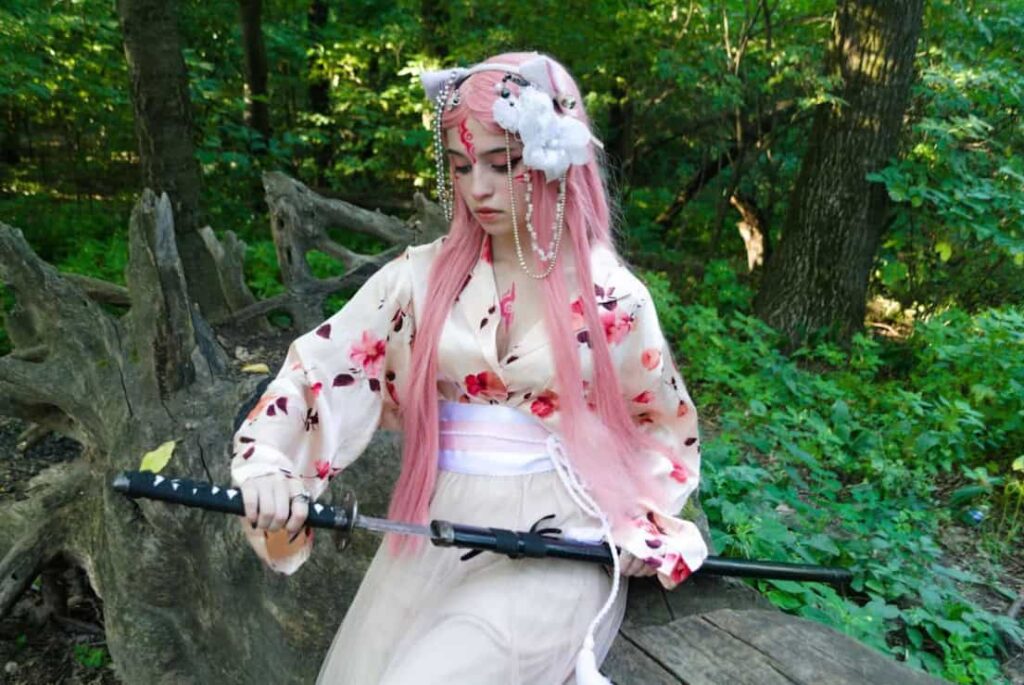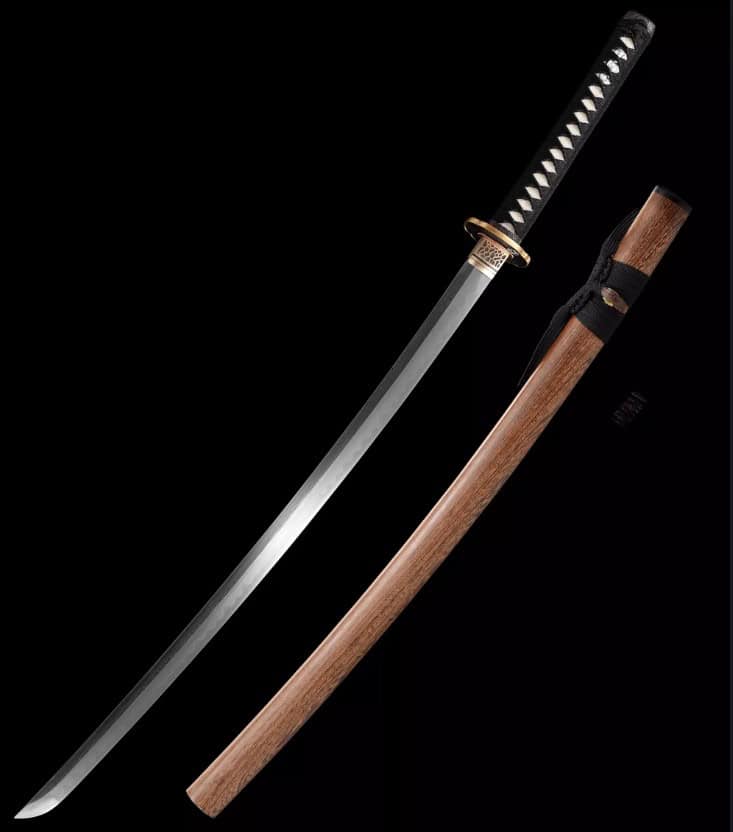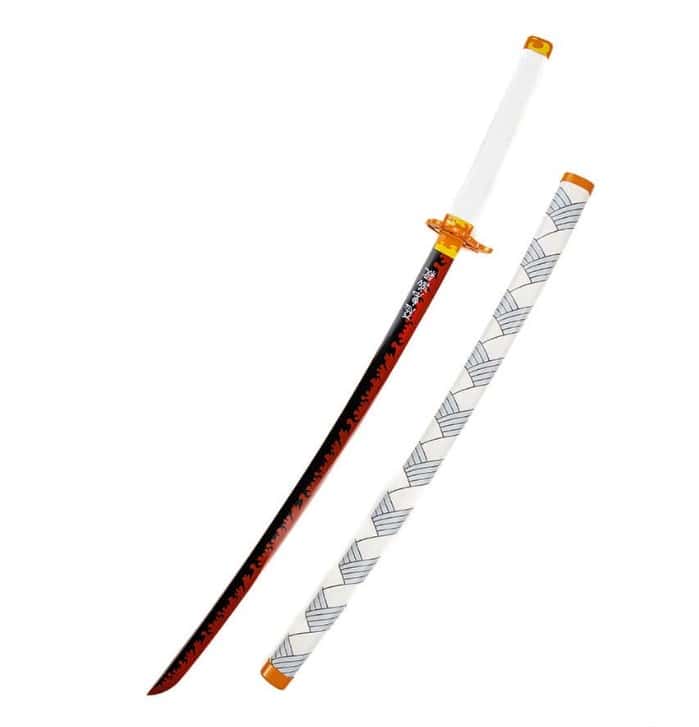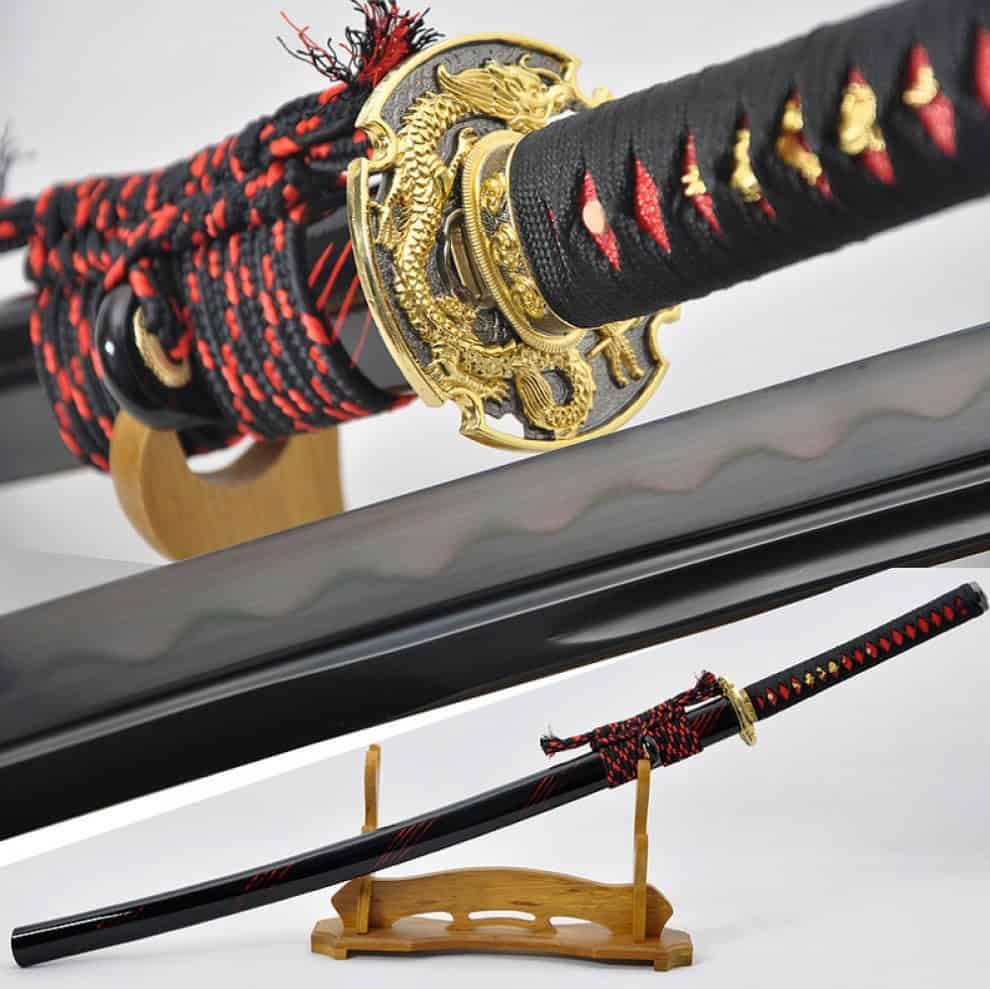What is a Katana?
TLDR: A katana is a traditional Japanese sword known for its curved, single-edged blade, distinctive tsuba (hand guard), and exceptional cutting ability, typically associated with samurai warriors.
The katana is a traditional Japanese sword characterized by its distinctive curved, single-edged blade. Typically measuring between 60 to 80 cm in length, this iconic weapon is renowned for its exceptional sharpness and craftsmanship.
Developed in the late 13th century, the katana became an integral part of samurai culture and warfare, symbolizing the warrior’s spirit, honor, and skill. Originally designed for close-quarters combat, the katana’s unique curvature and construction allowed for swift, powerful strikes.

Its creation was a response to the evolving needs of Japanese warriors, particularly during the Mongol invasions of 1274 and 1281. The katana’s effectiveness in battle, combined with its aesthetic appeal, elevated it beyond a mere weapon to a revered cultural artifact. Throughout Japanese history, the katana has held immense significance, not only as a military tool but also as a symbol of social status and spiritual importance.
Samurai considered their swords to be extensions of their souls, often performing purification rituals before battle to honor their weapons. This deep connection between warrior and blade has contributed to the katana’s enduring legacy in Japanese culture and its global recognition as a symbol of Japan’s rich martial tradition.
Dimensions of a Katana
The katana’s dimensions are crucial to its functionality and aesthetic appeal. These carefully considered measurements contribute to the sword’s effectiveness in combat and its revered status in Japanese culture.
Length and curvature
A typical katana blade measures between 60 to 80 cm (23.6 to 31.5 inches) in length. The blade’s distinctive curvature, known as “sori,” usually ranges from 1 to 3 cm (0.4 to 1.2 inches) at its deepest point. This curve enhances cutting power and allows for smoother drawing from the scabbard.
Weight and balance
A katana generally weighs between 1.1 to 1.5 kg (2.4 to 3.3 lbs). The sword’s balance point is typically located about 15 to 20 cm (5.9 to 7.9 inches) from the tsuba (guard). This careful weight distribution allows for swift, controlled movements, essential for the katana’s effectiveness in combat.
Blade composition/thickness
The katana blade is composed of high-carbon steel, often folded multiple times to create a strong, flexible structure. The blade’s thickness varies, usually measuring about 6 to 8 mm (0.24 to 0.31 inches) at the spine near the tsuba, tapering to about 2 to 3 mm (0.08 to 0.12 inches) near the cutting edge. This tapering contributes to the blade’s sharpness and durability, allowing it to maintain its edge while withstanding the rigors of combat.
Anatomy of a Katana
The katana is composed of several distinct parts, each contributing to its functionality and aesthetic appeal. Understanding these components is essential for appreciating the sword’s design and craftsmanship.
Blade (Ha)
The ha is the cutting edge of the katana. It’s characterized by its curved shape and razor-sharp edge. The blade consists of several parts, including the kissaki (point), shinogi (ridge line), and ji (flat surface). The ha is typically made from high-carbon steel and undergoes a complex forging and tempering process to achieve its renowned hardness and sharpness.
Hilt (Tsuka)
The tsuka is the handle of the katana. It’s usually made of wood wrapped in ray skin (same) and then tightly bound with silk or cotton cord (ito) in a specific pattern. This wrapping provides a secure grip and absorbs sweat. The tsuka also houses the tang of the blade (nakago) and is secured by a pin (mekugi).
Guard (Tsuba)
The tsuba is a decorative hand guard positioned between the blade and the hilt. It serves to protect the wielder’s hands and to balance the sword. Tsuba can be made from various materials, including iron, brass, or precious metals, and are often intricately designed with motifs from nature, mythology, or daily life.
Sheath/Scabbard (Saya)
The sheath or scabbard of a katana is called a saya. It’s typically made of lightweight wood, often magnolia, and lacquered for protection against moisture. The saya is designed to protect the blade when not in use and to allow for smooth drawing of the sword. It’s an integral part of the katana, contributing to its overall aesthetic and functionality.
Katana Craftsmanship
The creation of a katana is a meticulous process that combines ancient techniques with skilled artisanship, resulting in a blade of exceptional quality and beauty.
Traditional forging process
The crafting of a katana begins with the careful selection of high-carbon steel, known as tamahagane. The swordsmith, or katana kaji, heats the steel in a specially designed furnace called a tatara. The molten steel is then hammered and shaped into a rough blade form. This process requires precise control of temperature and timing to achieve the desired steel properties.
Folding and tempering techniques
One of the most crucial steps in katana forging is the folding of the steel. The smith repeatedly folds and hammers the metal, sometimes up to 16 times, creating thousands of layers within the blade. This process removes impurities and distributes carbon evenly, resulting in a stronger, more flexible blade. After shaping, the blade undergoes differential tempering. The edge is coated with clay, thinner at the cutting edge and thicker on the spine, before being heated and quenched. This creates the characteristic curved shape and the visible temper line (hamon) along the blade.
Polishing and finishing
Once forged and tempered, the katana undergoes an extensive polishing process, often taking as long as the forging itself. A skilled polisher (togishi) uses a series of increasingly fine grinding stones to reveal the blade’s grain pattern (hada) and to create its mirror-like finish. This polishing not only enhances the sword’s appearance but also refines its cutting edge. Finally, the blade is fitted with its hilt, guard, and other fittings, completing the katana’s transformation from raw steel to a work of functional art.
Historical Development of the Katana
The katana’s evolution spans centuries of Japanese history, reflecting changes in warfare, technology, and culture.
Origins and early forms
The katana’s predecessors emerged during the Kofun period (250-538 AD) with the introduction of straight, double-edged swords from China and Korea. These early blades evolved into the tachi, a longer, more curved sword worn edge-down, which was popular among mounted samurai. The transition from tachi to katana began in the late Kamakura period (1185-1333) as combat styles shifted from horseback to infantry warfare.

Evolution during feudal Japan
The Muromachi period (1336-1573) saw significant developments in katana design. Swordsmiths refined forging techniques, creating blades with improved durability and cutting power. The sword’s curve became more pronounced, and the blade was shortened for easier use in close-quarters combat. This period also witnessed the emergence of legendary swordsmiths like Masamune, whose blades are still revered today.
Standardization in the Edo period
During the peaceful Edo period (1603-1868), the katana’s role shifted from a battlefield weapon to a symbol of samurai status. This era saw increased standardization in katana production. The shogunate implemented regulations on sword length and quality, leading to more uniform designs. The focus on craftsmanship intensified, with swordsmiths developing intricate decorative techniques for tsuba (guards) and other fittings. Despite reduced combat use, the katana remained central to samurai identity and martial arts training throughout this period.
Katana in Popular Culture
The katana has become a prominent fixture in various forms of media, often portrayed with heightened capabilities and symbolic significance.
Representation in films and anime
Katanas frequently appear in action movies, samurai films, and anime series, often depicted as weapons of unparalleled sharpness and power. In Hollywood productions like “Kill Bill” and “The Last Samurai,” katanas are showcased as formidable weapons wielded by skilled protagonists. Anime series such as “Rurouni Kenshin” and “Bleach” feature katanas prominently, often imbuing them with supernatural abilities or spiritual significance.
The “Yuta katana” refers to the sword wielded by Yuta Okkotsu, a character from the popular manga and anime series “Jujutsu Kaisen.” In the series, Yuta’s katana is imbued with cursed energy, making it a powerful weapon against supernatural threats. This fictional representation exemplifies how modern media often combines traditional katana imagery with fantastical elements.
The Demon-Slasher Katana from the anime and manga series “Black Clover” is a unique Anti Magic Weapon that exemplifies the fantastical treatment of katanas in popular culture. Originally belonging to Yami Sukehiro, this sword was transformed by the Anti Magic in Asta’s devil arm when passed to him.
The katana is stored as writing within a grimoire and can be easily summoned without consuming magical power. Its Anti Magic properties allow it to cut through spells and magic, and it can release flying slashes of Anti Magic. When used with the Unite technique, these slashes selectively damage only intended targets while sparing what the user wishes to protect.
How to Display a Katana
Displaying a katana properly not only showcases its beauty but also helps preserve the sword. There are several methods to display a katana, with the most common being a katana display case.
Katana display case
A purpose-built katana display case is an excellent option for showcasing and protecting your sword. These cases are typically made of wood or acrylic and often feature a felt-lined interior to prevent scratches. Many display cases are designed to hold the katana horizontally, which is the traditional way of displaying these swords. Some cases include a stand for the scabbard (saya) and may have additional compartments for displaying other sword fittings.
Additional display methods
- Wall-mounted racks: Specially designed sword racks can be mounted on walls, allowing for vertical display of one or multiple katanas.
- Sword stands: Free-standing wooden or metal stands can hold a katana vertically or at an angle, making for an elegant display option.
- Traditional sword rack (katanakake): This is a multi-tiered stand used in Japan to store multiple swords horizontally.
- Table display: A simple cloth-covered table can be used to display a katana horizontally, though this method offers less protection.
Considerations for proper display
- Avoid direct sunlight, which can fade the saya and damage the blade.
- Maintain a stable environment with controlled temperature and humidity to prevent rust and degradation of organic components.
- If displaying the blade unsheathed, ensure it’s properly oiled to prevent corrosion.
- Handle the katana with clean, dry hands or wear gloves to avoid transferring oils and moisture.
- Regularly inspect and clean the katana to maintain its condition.
Where Can I Find a Real Katana for Sale?
If you’re looking to own a katana, there are several options to consider, each catering to different needs and budgets.
TrueKatana

What I Like:
- Damascus steel full tang blade: The blade is crafted from Damascus steel, featuring a unique pattern, high strength, and sharpness, with a genuine hamon for added strength and flexibility.
- Black cord handle with real white samegawa: The handle is adorned with real white ray skin for a textured grip, complemented by black cord wrappings for both functionality and elegance.
- Wengewood saya with natural wood color: The scabbard is made from durable wengewood with a beautiful grain, creating a striking visual contrast with the dark handle and shimmering blade.
Mini Katana

What I Like:
- Handcrafted Design: Each sword is expertly handcrafted using time-honored techniques, ensuring a unique piece that honors tradition, culture, and craftsmanship.
- Durable 1045 Carbon Steel: The blade is made from 1045 Carbon Steel, which is tough and durable, making it the best affordable option for any collection.
- Full-Tang Construction: The blade extends throughout the entire length of the handle, providing ideal stability and durability for practical use.
Swords of Northshire

What I Like:
- Sharp and Durable Blade: The blade is very sharp, folded 13 times to create over 8,000 layers, making it durable enough for cutting tameshigiri and bamboo.
- Premium Materials: It features genuine rayskin, a white lacquered hardwood saya, silk ito, and premium brass fittings, ensuring high quality and authenticity.
- Handmade Craftsmanship: Each sword is individually handmade, hand-sharpened, full tang, and battle-ready, making it a functional and unique replica of Roronoa Zoro’s Wado Ichimonji Sword.
Kult of Athena

What I Like:
- Low maintenance: The modern materials used in this katana make it perfect for today’s urban warrior with minimal upkeep required.
- Secure grip: The tsuka, encapsulating the tang in textured G10 and dual pinned, ensures a secure and reliable grip.
- Stylish design: The silver menuki featuring shi shi (lion dogs) embedded in the handle and the textured black saya with olive paracord sageo add an elegant touch to the katana’s modern aesthetic.
Hanbon Forge

What I Like:
- Craftsmanship and Materials: The katana is crafted from black folded steel with 8192 layers and has been differentially clay tempered, ensuring exceptional durability and a beautiful traditional Japanese curve.
- Design and Aesthetics: The sword features a fine finished dragon design alloy tsuba and menuki, and a handle wrapped in red genuine ray skin with black synthetic silk, giving it a striking and elegant appearance.
- Functionality and Authenticity: It has a full tang blade in the “Unokubi-Zukuri” style, is double-pinned with bamboo mekugi for secure handling, and can be fully disassembled and assembled, making it both a functional weapon and a collectible item.
FAQs
Are serrated katanas real?
Serrated katanas are not traditional or historically accurate. Authentic katanas have a smooth, curved blade. Serrated versions are likely modern novelty items or fantasy creations, not representative of true Japanese swordsmanship.
Which way should a katana face?
While katanas are exceptionally sharp and strong, they are not designed to cut through other swords or metal objects. This capability is often exaggerated in popular media. In reality, attempting to cut through metal would likely damage the katana’s blade.
Can a katana cut through other swords or metal objects?
While katanas are exceptionally sharp and strong, they are not designed to cut through other swords or metal objects. This capability is often exaggerated in popular media. In reality, attempting to cut through metal would likely damage the katana’s blade.
Is it legal to own a katana?
Laws regarding katana ownership vary by country and region. In many places, replica or modern-made katanas are legal, while antique swords may have restrictions. It’s important to check local laws before purchasing or owning a katana.
What is the purpose of the curve in a katana blade?
The curve in a katana blade, known as “sori,” serves two main purposes: It enhances cutting power by creating a slicing motion during strikes. And it allows for a smoother drawing of the sword from the scabbard (saya). The curvature typically ranges from 1 to 3 cm at its deepest point, contributing to the katana’s effectiveness in combat and its distinctive appearance.
Final Thoughts
I think the katana is a true masterpiece of craftsmanship, balancing elegant design with lethal functionality. Its curved blade and intricate hilt make it visually stunning, and its historical significance as a symbol of samurai honor adds to its allure.
On the downside, maintaining a katana can be pretty demanding, requiring regular oiling and cleaning to prevent rust. Plus, the way katanas are often depicted in popular culture can create some unrealistic expectations about what they can actually do.
Despite these minor drawbacks, I can’t help but admire the katana. It’s a beautiful blend of art and martial tradition, and it holds a special place in my heart for its rich cultural significance and sheer elegance.
Some links on this site are affiliate links, which means if you click and buy something, we get a tiny commission—like a virtual high-five in cash form (don’t worry, it costs you nothing).
